Buckwheat
| Common Buckwheat | |
|---|---|
 |
|
| Scientific classification | |
| Kingdom: | Plantae |
| Division: | Magnoliophyta |
| Class: | Magnoliopsida |
| Order: | Caryophyllales |
| Family: | Polygonaceae |
| Genus: | Fagopyrum |
| Species: | F. esculentum |
| Binomial name | |
| Fagopyrum esculentum Moench |
|
Buckwheat refers to plants in two genera of the dicot family Polygonaceae: the Eurasian genus Fagopyrum, and the North American genus Eriogonum. The crop plant, common buckwheat, is Fagopyrum esculentum. Tartary buckwheat (F. tataricum Gaertn.) or "bitter buckwheat" is also used as a crop, but it is much less common. Despite the common name and the grain-like use of the crop, buckwheat is not a cereal or grass. It is called a pseudocereal to emphasize that it is not related to wheat.
Buckwheat plants are fast growers, producing seed in about 6 weeks and growing about 30 inches (760 mm) tall.[1]
The agricultural weed known as Wild Buckwheat (Fallopia convolvulus) is in the same family, but not closely related to the crop species. Within Fagopyrum, the cultivated species are in the cymosum group, with F. cymosum L. (perennial buckwheat), F. giganteum and F. homotropicum.[2] The wild ancestor of common buckwheat is F. esculentum ssp.ancestrale. F. homotropicum is interfertile with F. esculentum and the wild forms have a common distribution, in Yunnan. The wild ancestor of tartary buckwheat is F. tataricum ssp. potanini.[3]
Contents |
Etymology
The name 'buckwheat' or 'beech wheat' comes from its triangular seeds, which resemble the much larger seeds of the beech nut from the beech tree, and the fact that it is used like wheat. The etymology of the word is explained as partial translation of Middle Dutch boecweite : boek, beech; see PIE bhago- + weite, wheat.[4]
History
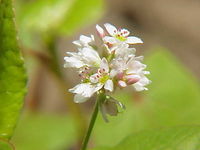
Common buckwheat was domesticated and first cultivated in inland southeast Asia, possibly around 6000 BC, and from there spread to Central Asia and Tibet, and then to the Middle East and Europe. Domestication most likely took place in the western Yunnan region of China.[5] Buckwheat is documented in Europe in the Balkans by at least the Middle Neolithic (circa 4000 BC) and the oldest known remains in China so far date to circa 2600 BC, and buckwheat pollen has been found in Japan from as early as 4000 BC. It is the world's highest elevation domesticate, being cultivated in Yunnan on the edge of the Tibetan Plateau or on the Plateau itself. Buckwheat was one of the earliest crops introduced by Europeans to North America. Dispersal around the globe was complete by 2006, when a variety developed in Canada was widely planted in China.
Buckwheat is a short season crop that does well on low-fertility or acidic soils, but the soil must be well drained. Too much fertilizer, especially nitrogen, will reduce yields. In hot climates, it can only be grown by sowing late in the season, so that it will bloom in cooler weather. The presence of pollinators greatly increases the yield. The nectar from buckwheat flower makes a dark colored honey. Buckwheat is sometimes used as a green manure, as a plant for erosion control, or as wildlife cover and feed.
Agricultural production
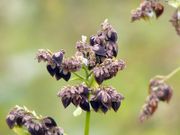
Historical data
A century ago, Russia was the world leader in buckwheat production.[6] Growing areas in the Russian Empire were estimated at 6.5 million acres (26,000 km²), followed by those of France (0.9 million acres; 3,500 km²).[7] In 1970 the Soviet Union grew an estimated 4.5 million acres (18,000 km²) of buckwheat. China was then the world's top producer until 2005, with Russia becoming once again the top producer after 2007.
In the northeastern United States, buckwheat was a common crop in the 18th and 19th centuries. Cultivation declined sharply in the 20th century due the use of nitrogen fertilizer, to which maize and wheat respond strongly. Over a million acres (4,000 km²) were harvested in the United States in 1918. By 1954 that had declined to 150,000 acres (600 km²), and by 1964, the last year that production statistics were gathered, only 50,000 acres (200 km²) were grown.
Present-day production
Common buckwheat is by far the most important buckwheat species, economically, accounting for over 90% of the world's buckwheat production.
| Buckwheat | Cultivated area (hectares) |
Yield (hectograms/ha) |
Production (tonnes) |
Seed (tonnes) |
||||||||||
|---|---|---|---|---|---|---|---|---|---|---|---|---|---|---|
| Countries | 2005 | 2007 | 2005 | 2007 | 2005 | 2007 | 2005 | |||||||
| 833 600 | 1 305 000 | 7 265 | e | 7 700 | e | 605 640 | 1 004 850 | 69 500 | s | |||||
| 834 000 | e | 900 000 | e | 8 992 | 8 888 | 750 000 | e | 800 000 | e | 87 570 | e | |||
| 396 200 | 237 000 | 6 933 | e | 6 751 | e | 274 700 | 160 000 | 20 500 | s | |||||
| 36 593 | 32 945 | 33 945 | e | 35 558 | e | 124 217 | 117 148 | 3 293 | e | |||||
| 67 531 | 90 000 | e | 10 675 | e | 9 777 | e | 72 096 | 88 000 | e | 5 500 | e | |||
| 55 000 | 142 600 | 10 545 | e | 5 610 | e | 58 000 | s | 80 000 | e | 3 200 | s | |||
| 65 000 | e | 68 000 | e | 10 000 | e | 10 000 | e | 65 000 | e | 68 000 | e | 2 600 | e | |
| 46 000 | e | 48 000 | e | 10 869 | e | 10 833 | e | 50 000 | e | 52 000 | e | 2 760 | e | |
| 44 700 | 44 600 | e | 6 979 | e | 7 623 | e | 31 200 | 34 000 | e | 1 341 | e | |||
| 28 400 | 21 700 | 5 528 | e | 9 631 | e | 15 700 | 20 900 | 2 500 | e | |||||
| 7 106 | 11 500 | 10 227 | e | 11 304 | e | 7 268 | 13 000 | 1 000 | e | |||||
| 10 400 | 13 000 | e | 9 519 | e | 6 307 | e | 9 900 | 8 200 | e | |||||
| 4 500 | e | 4 600 | e | 14 888 | e | 14 782 | e | 6 700 | 6 800 | e | 360 | e | ||
| 2 257 | 2 650 | e | 9 937 | e | 11 320 | e | 2 243 | 3 000 | e | 90 | e | |||
| 4 000 | 2 000 | 11 500 | e | 11 500 | e | 4 600 | 2 300 | 300 | e | |||||
| 1 000 | e | 20 000 | e | 2 000 | e | 26 | e | |||||||
| 811 | 809 | 17 916 | e | 9 406 | e | 1 453 | 761 | 52 | e | |||||
| 752 | 800 | e | 6 156 | e | 5 000 | e | 463 | 400 | e | 60 | e | |||
| 676 | 314 | 7 174 | e | 9 554 | e | 485 | 300 | |||||||
| 461 | 500 | e | 8 872 | e | 6 000 | e | 409 | 300 | e | |||||
| 2 811 | 7 200 | e | 3 429 | e | 416 | e | 964 | 300 | e | 252 | e | |||
| 378 | 600 | e | 9 179 | e | 8 333 | e | 347 | 500 | e | |||||
| 1 000 | e | 1 000 | e | 3 000 | e | 3 000 | e | 300 | e | 300 | e | 65 | e | |
| 45 | e | 31 111 | e | 140 | e | 2 | e | |||||||
| 100 | e | 100 | e | 10 000 | e | 10 000 | e | 100 | s | 100 | e | |||
| World | 2 443 321 | a | 2 934 918 | a | 8 529 | e | 8 385 | e | 2 083 925 | a | 2 461 159 | a | 200 974 | a |
|
||||||||||||||||||||
Chemical composition
| Seeds | Starch | 71–78% in groats 70–91% in different types of flour.[8][9][10] |
|
| Proteins | 18% with biological values above 90%.[11] This can be explained by a high concentration of all essential amino acids[12], especially lysine, threonine, tryptophan, and the sulphur-containing amino acids.[13] |
||
| Minerals | Rich in iron (60–100 ppm), zinc (20–30 ppm) and selenium (20–50 ppb).[14][15] | ||
| Antioxidants | 10–200 ppm of rutin and 0.1–2% of tannins[16] | ||
| Aromatic compounds | Salicylaldehyde (2-hydroxybenzaldehyde) was identified as a characteristic component of buckwheat aroma[17]. 2,5-dimethyl-4-hydroxy-3(2H)-furanone, (E,E)-2,4-decadienal, phenylacetaldehyde, 2-methoxy-4-vinylphenol, (E)-2-nonenal, decanal and hexanal also contribute to its aroma. They all have odour activity value more than 50, but aroma of these substances in isolated state does not resemble buckwheat[18]. | ||
| Herb | Antioxidants | 1–10% rutin and 1–10% tannins[19] | |
| Fagopyrin | 0.4 to 0.6 mg/g of fagopyrins (at least 3 similar substances)[20][21] |
Use

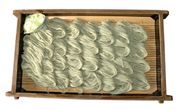
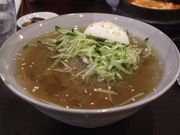
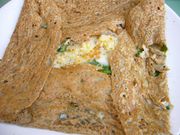
The fruit is an achene, similar to sunflower seed, with a single seed inside a hard outer hull. The starchy endosperm is white and makes up most or all of buckwheat flour. The seed coat is green or tan, which darkens buckwheat flour. The hull is dark brown or black, and some may be included in buckwheat flour as dark specks. The dark flour is known as 'blé noir' ('black wheat') in French, along with the name sarrasin ('saracen').
Buckwheat noodles play a major role in the cuisines of Japan (soba)[22], Korea (naengmyeon, makguksu and memil guksu) and the Valtellina region of Northern Italy (pizzoccheri). Soba noodles are the subject of deep cultural importance in Japan. In Korea, guksu (noodles) were widely made from buckwheat before it was replaced by wheat. The difficulty of making noodles from flour that has no gluten has resulted in a traditional art developed around their manufacture by hand.
Buckwheat groats are commonly used in western Asia and eastern Europe. The porridge was common, and is often considered the definitive peasant dish. It is made from roasted groats that are cooked with broth to a texture similar to rice or bulgur. The dish was brought to America by Russian and Polish immigrants who called it "kasha" and mixed it with pasta or used it as a filling for knishes and blintzes, and hence buckwheat groats are most commonly called kasha in America. Groats were the most widely used form of buckwheat worldwide during the 20th century, with consumption primarily in Russia, Ukraine and Poland. The groats can also be sprouted and then eaten raw or cooked.
Buckwheat pancakes, sometimes raised with yeast, are eaten in several countries. They are known as buckwheat blinis in Russia, galettes in France (savoury crêpes which are especially associated with Brittany), ployes in Acadia and boûketes (which are named after the buckwheat plant) in the Wallonia region of Belgium. Similar pancakes were a common food in American pioneer days. They are light and foamy. The buckwheat flour gives them an earthy, mildly mushroom-like taste. In Ukraine, yeast rolls called hrechanyky are made from buckwheat.
Farina made from groats are used for breakfast food, porridge, and thickening materials in soups, gravies, and dressings. In Korea, buckwheat starch is used to make a jelly called memilmuk. It is also used with wheat, maize (polenta taragna in Northern Italy) or rice in bread and pasta products.
Buckwheat contains no gluten[23] and can thus be eaten by people with coeliac disease or gluten allergies. Many bread-like preparations have been developed. However, Buckwheat can be a potent and potentially fatal allergen by itself. In sensitive people, it provokes IgE-mediated anaphylaxis[24]. The cases of anaphylaxis induced by buckwheat ingestion have been reported in Korea, Japan and Europe where it is more often described as a "hidden allergen"[25][26].
Buckwheat is a good honey plant, producing a dark, strong[27] monofloral honey.
Medicinal uses
Buckwheat contains a glucoside named rutin, a medicinal chemical that strengthens capillary walls, reducing hemorrhaging in people with high blood pressure and increasing microcirculation in people with chronic venous insufficiency.[28] Dried buckwheat leaves for tea were manufactured in Europe under the brand name "Fagorutin."
Buckwheat contains D-chiro-inositol, a component of the secondary messenger pathway for insulin signal transduction found to be deficient in Type II diabetes and Polycystic ovary syndrome (PCOS). It is being studied for use in treating Type II diabetes.[29] Research on D-chiro-inositol and PCOS has shown promising results.[30][31]
A buckwheat protein has been found to bind cholesterol tightly. It is being studied for reducing plasma cholesterol in people with hyperlipidemia.[32]
Upholstery filling
Buckwheat hulls are used as filling for a variety of upholstered goods, including pillows and zafu. The hulls are durable and do not conduct or reflect heat as much as synthetic fills. They are sometimes marketed as an alternative natural fill to feathers for those with allergies. However, medical studies to measure the health effects of buckwheat hull pillows concluded that buckwheat pillows do emit a potential allergen that may trigger asthma in susceptible individuals.[33][34]
Buckwheat and beer
In recent years, buckwheat has been used as a substitute for other grain in gluten free beer. Although it is not a cereal, buckwheat can be used in the same way as barley to produce a malt that can form the basis of a mash that will brew a beer without gliadin or hordein (together gluten) and therefore can be suitable for coeliacs or others sensitive to certain glycoproteins.[35]
Festivals
The buckwheat plant is celebrated in Kingwood, West Virginia at their Buckwheat Festival where people can participate in swine, cow, and sheep judging contests, vegetable contests, and craft fairs. The area fire departments also play an important role in the series of parades that occur there. Each year there is a King Buckwheat and Queen Ceres elected. Also there are many rides and homemade, homegrown buckwheat cakes and sausage.
On Hindu fasting days (Navaratri mainly, also Maha Shivaratri), northern states of India eat items made of buckwheat flour. The preparation varies across India. The famous ones are Kuttu Ki Puri and Kuttu Pakoras. In most of northern and western states they call this Kuttu ka atta .
Biocontrol
Buckwheat is currently being researched, and actively used, as a pollen and nectar source to increase natural predator numbers to control crop pests in New Zealand[36]
Agricultural Use
Buckwheat is raised for grain where a short season is available, either because it is used as a second crop in the season, or because the climate is limiting.
Buckwheat can be reliable cover crop in summer to fit a small slot of warm season for establishment. It establishes quickly, which suppresses summer weeds.
Recipes
- "Recipe for buckwheat that does not stick". ASAN. http://www.asiteaboutnothing.net/f_kasha.html. Retrieved 2009-05-13.
- "Buckwheat pancakes". BBC. http://www.bbc.co.uk/food/recipes/database/buckwheatpancakes_80141.shtml. Retrieved 2008-02-26.
- "Buckwheat noodles with smoked salmon and dill". BBC. http://www.bbc.co.uk/food/recipes/database/buckwheatnoodleswith_77288.shtml. Retrieved 2008-02-26.
- "Recipe for Buckwheat Porridge". DukeLupus. http://thisfoodthing.com/index.php/2007/07/14/buckwheat-porridge-recipe-by-dukelupus/. Retrieved 2008-02-26.
See also
- Eriogonum – North American wild buckwheat
References
- ↑ http://www.nysaes.cornell.edu/hort/faculty/bjorkman/covercrops/buckwheatbrochure.html
- ↑ T. Sharma, S. Jana (2002). "Species relationships in Fagopyrum revealed by PCR-based DNA fingerprinting". Theoretical and Applied Genetics 105 (2-3): 306–312. doi:10.1007/s00122-002-0938-9. PMID 12582533.
- ↑ Ohnishi, O., Matsuoka, Y. (1996). "Search for the wild ancestor of buckwheat II. Taxonomy of Fagopyrum (Polygonaceae) species based on morphology, isozymes and cpDNA variability". Genes and Genetic Systems 71: 383–390. doi:10.1266/ggs.71.383.
- ↑ http://www.etymonline.com/index.php?term=buckwheat Online Etymology Dictionary
- ↑ Ohnishi, O (1998). "Search for the wild ancestor of buckwheat III. The wild ancestor of cultivated common buckwheat, and of tatary buckwheat". Economic Botany 52: 123–133.
- ↑ William Pokhlyobkin. "The Plight of Russian Buckwheat". http://vkus.narod.ru/raznoe/grechiha.htm. (Russian) Title in Russian: Тяжёлая судьба русской гречихи
- ↑ J. R. N. Taylor, P. S. Belton (2002). Pseudocereals and Less Common Cereals. Springer. p. 125. ISBN 3540429395.
- ↑ Skrabanja V, Kreft I, Golob T, Modic M, Ikeda S, Ikeda K, Kreft S, Bonafaccia G, Knapp M, Kosmelj K. (2004). "Nutrient content in buckwheat milling fractions". Cereal Chemistry 81 (2): 172–176. doi:10.1094/CCHEM.2004.81.2.172.
- ↑ Skrabanja V, Laerke HN, Kreft I (September 1998). "Effects of hydrothermal processing of buckwheat Fagopyrum esculentum Moench) groats on starch enzymatic availability in vitro and in vivo in rats". Journal of Cereal Science 28 (2): 209–214. doi:10.1006/jcrs.1998.0200.
- ↑ Skrabanja V, Elmstahl HGML, Kreft I, Bjorck IME (January 2001). "Nutritional properties of starch in buckwheat products: Studies in vitro and in vivo". Journal of Agricultural and Food Chemistry 49 (1): 490–496. doi:10.1021/jf000779w. PMID 11170616.
- ↑ Eggum BO, Kreft I, Javornik B (1980). "Chemical-Composition and Protein-Quality of Buckwheat (Fagopyrum esculentum Moench)". Qualitas Plantarum-Plant Foods for Human Nutrition 30 (3-4): 175–9. doi:10.1007/BF01094020.
- ↑ Buckwheat Profile
- ↑ Bonafaccia G, Marocchini M, Kreft I (2003). "Composition and technological properties of the flour and bran from common and tartary buckwheat". Food Chemistry 80 (1): 9–15. doi:10.1016/S0308-8146(02)00228-5.
- ↑ S. Ikeda, Y. Yamashita and I. Kreft (2000). "Essential mineral composition of buckwheat flour fractions". Fagopyrum 17: 57–61.
- ↑ Bonafaccia, L. Gambelli, N. Fabjan and I. Kreft (October 2003). "Trace elements in flour and bran from common and tartary buckwheat". Food Chemistry 83 (1): 1–5. doi:10.1016/S0308-8146(03)00228-0.
- ↑ Kreft S, Knapp M, Kreft I (November 1999). "Extraction of rutin from buckwheat (Fagopyrum esculentum Moench) seeds and determination by capillary electrophoresis". Journal of Agricultural and Food Chemistry 47 (11): 4649–52. doi:10.1021/jf990186p. PMID 10552865.
- ↑ Janes D, Kreft S (2008). "Salicylaldehyde is a characteristic aroma component of buckwheat groats". Food Chemistry 109 (2): 293–8. doi:10.1016/j.foodchem.2007.12.032.
- ↑ Janes D, Kantar D, Kreft S, Prosen H (1. January 2009). "Identification of buckwheat (Fagopyrum esculentum Moench) aroma compounds with GC-MS". Food Chemistry 112 (1): 120–4. doi:10.1016/j.foodchem.2008.05.048.
- ↑ Kreft S, Strukelj B, Gaberscik A, Kreft I (August 2002). "Rutin in buckwheat herbs grown at different UV-B radiation levels: comparison of two UV spectrophotometric and an HPLC method". J Exp Bot 53 (375): 1801–4. doi:10.1093/jxb/erf032. PMID 12147730.
- ↑ Eguchi K, Anase T and Osuga H (2009). "Development of a High-Performance Liquid Chromatography Method to Determine the Fagopyrin Content of Tartary Buckwheat (Fagopyrum tartaricum Gaertn.) and Common Buckwheat (F. esculentum Moench)". Plant Production Science 12 (4): 475–480. doi:10.1626/pps.12.475.
- ↑ Ožbolt L, Kreft S, Kreft I, Germ M and Stibilj V (2008). "Distribution of selenium and phenolics in buckwheat plants grown from seeds soaked in Se solution and under different levels of UV-B radiation". Food Chemistry 110 (3): 691–6. doi:10.1016/j.foodchem.2008.02.073.
- ↑ P. S. Belton; John Reginald Nuttall Taylor (2002). Pseudocereals and Less Common Cereals : grain properties and utilization potential. Springer. p. 138. ISBN 3-540-42939-5. http://books.google.com/books?id=NRMdXx8fC8kC&pg=PA138&dq=soba+Japan#v=onepage&q=soba%20Japan&f=false.
- ↑ "Gluten Free Diet". Celiac Disease Center. University of Chicago. http://www.celiacdisease.net/gluten-free-diet. Retrieved 2009-03-31.
- ↑ Schiffner R, Przybilla B, Burgdorff T, Landthaler M, Stolz W (October 2001). "Anaphylaxis to buckwheat". Allergy 56 (10): 1020–1. PMID 11576091. http://www3.interscience.wiley.com/resolve/openurl?genre=article&sid=nlm:pubmed&issn=0105-4538&date=2001&volume=56&issue=10&spage=1020.
- ↑ Lee SY, Oh S, Lee K, et al. (August 2005). "Murine model of buckwheat allergy by intragastric sensitization with fresh buckwheat flour extract". J. Korean Med. Sci. 20 (4): 566–72. PMID 16100445. PMC 2782149. http://jkms.org/DOIx.php?id=10.3346/jkms.2005.20.4.566.
- ↑ Heffler E, Guida G, Badiu I, Nebiolo F, Rolla G (2007). "Anaphylaxis after eating Italian pizza containing buckwheat as the hidden food allergen". J Investig Allergol Clin Immunol 17 (4): 261–3. PMID 17694699. http://www.jiaci.org/issues/vol17issue04/9.pdf.
- ↑ http://vegetarian.lovetoknow.com/Buckwheat_Honey
- ↑ Ihme, N.; H. Kiesewetter, F. Jung, K. H. Hoffmann, A. Birk, A. Müller, K. I. Grützner (1996-07-12). "Leg oedema protection from a buckwheat herb tea in patients with chronic venous insufficiency: a single-centre, randomised, double-blind, placebo-controlled clinical trial". Eur J Clin Pharmacol 50 (6): 443–447. doi:10.1007/s002280050138. PMID 8858269.
- ↑ Kawa, J.M., Taylor, C.G., Przybylski, R. (1996). "Buckwheat Concentrate Reduces Serum Glucose in Streptozotocin-Diabetic Rats". J. Agric. Food Chem 50: 443–7.
- ↑ Nestler JE, Jakubowicz DJ, Reamer P, Gunn RD, Allan G (1999). "Ovulatory and metabolic effects of D-chiro-inositol in the polycystic ovary syndrome". N. Engl. J. Med. 340 (17): 1314–20. doi:10.1056/NEJM199904293401703. PMID 10219066.
- ↑ Iuorno MJ, Jakubowicz DJ, Baillargeon JP, et al. (2002). "Effects of d-chiro-inositol in lean women with the polycystic ovary syndrome". Endocrine practice 8 (6): 417–23. PMID 15251831.
- ↑ H. Tomotake, I. Shimaoka, J. Kayashita, F. Yokoyama, M. Nakajoh and N. Kato. (2001). "Stronger suppression of plasma cholesterol and enhancement of the fecal excretion of steroids by a buckwheat protein product than by a soy protein isolate in rats fed on a cholesterol-free diet.". Bioscience Biotechnology and Biochemistry 65: 1412–4. doi:10.1271/bbb.65.1412.
- ↑ Chein Soo Hong, Hae Sim Park and Seung Heon Oh (December 1987). "Dermatophagoides Farinae, an Important Allergenic Substance in Buckwheat-Husk Pillows" (PDF). Yonsei Medical Journal 28 (4): 274–281. http://www.eymj.org/1987/pdf/274.pdf.
- ↑ Hae-Seon Nam, Choon-Sik Park, Julian Crane, Rob Siebers (2004). "Endotoxin and House Dust Mite Allergen Levels on Synthetic and Buckwheat Pillows" (PDF). Journal of Korean Medical Science 19 (4): 505–8. ISSN 1011-8934. PMID 15308838. http://jkms.kams.or.kr/2004/pdf/08505.pdf.
- ↑ Carolyn Smagalski (2006). "Gluten Free Beer Festival". http://www.glutenfreebeerfestival.com.
- ↑ Berndt LA, Wratten SD, Hassan PG (2002). "Effects of buckwheat flowers on leafroller (Lepidoptera: Tortricidae) parasitoids in a New Zealand vineyard". Agricultural and Forest Entomology 4 (1): 39–45. doi:10.1046/j.1461-9563.2002.00126.x. http://www3.interscience.wiley.com/journal/118927753/abstract.
External links
- E.S. Oplinger, E.A. Oelke, M.A. Brinkman and K.A. Kelling (November 1989). "Buckwheat". Alternative Field Crops Manual. http://www.hort.purdue.edu/newcrop/afcm/buckwheat.html. Retrieved 2008-02-26.
- Damania, A.B. (1998). "Diversity of Major Cultivated Plants Domesticated in the Near East". Proceedings of the Harlan Symposium. http://www.ipgri.cgiar.org/publications/HTMLPublications/47/ch07.htm.
- Chun H.N., Chung C.K., Kang I.J., Kim E.R., Kim Y.S. (2003). "Effect of Germination on the Nutritional Value of Buckwheat Seed". Division of Life Sciences at Hallym University, South Korea. http://ift.confex.com/ift/2003/techprogram/paper_17126.htm.
- Mazza, G. (1992). "Buckwheat (Fagopyrum esculentum), the crop and its importance". In MacRae, R.. Encyclopedia of food science, food technology and nutrition. London: Academic Press Ltd.. pp. 534–9.
- Mazza, G. (1993). "Storage, Processing, and Quality Aspects of Buckwheat Seed". In Janick J., Simon J.E.. New crops. New York: Wiley. pp. 251–5.
- Marshall, H.G. and Y. Pomeranz. (1982). "Buckwheat description, breeding, production and utilization". In Y. Pomeranz. Advances in cereal science and technology. St. Paul, MN.: Amer. Assoc. Cereal Chem.. pp. 157–212.
- McGregor, S.E. (1976). "9 Crop Plants and Exotic Plants — Buckwheat". Insect Pollination Of Cultivated Crop Plants. U.S. Department of Agriculture. http://gears.tucson.ars.ag.gov/book/chap9/buckwheat.html. As found on the website of the Carl Hayden Bee Research Center of the USDA Agricultural Research Service.[]
- Multilingual taxonomic information from the University of Melbourne
- Clayton G. Campbell (1997). Buckwheat Fagopyrum esculentus Moench. Promoting the conservation and use of underutilized and neglected crops. 19. International Plant Genetic Resources Institute, Rome, Italy. http://www.bioversityinternational.org/Publications/pubfile.asp?ID_PUB=343.
- Descriptors for Buckwheat (Fagopyrum spp.)
- Nutritional information for buckwheat
- Buckwheat (Fagopyrum spp.)
- Fagopyrum Journal Archive
|
|||||